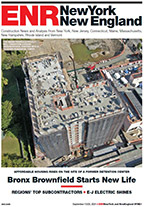September Construction Starts Climb 13% Nationwide
Nonbuilding construction, at $169.9 billion (annual rate), increased 33% in September. Electric utility construction surged 466% after a weak August, departing from the declining trend experienced during most of 2013. Large electric-utility projects that reached the construction start stage in September included a $1.9-billion wind farm in Iowa, a $1.1-billion natural gas power plant in Virginia, a $700-million solar power facility in Nevada and a $260-million transmission line grid in New Jersey.
The combined public works categories dropped 4% in September, as bridge construction fell a steep 61% from its elevated August amount, which included several large projects. The remaining public-works categories in September showed gains relative to August. River/harbor development jumped 55%, lifted by $615-million for canal work in the New Orleans area.
Sewer construction advanced 23%, while water supply systems increased 12%. The miscellaneous public works category, which includes sitework, rose 13% in September, lifted by $360 million for sitework at the planned Manhattan West complex in New York City.
Residential Building
Residential building in September dropped 6% to $203.2 billion (annual rate). Multifamily housing fell 14%, pulling back after rising by the same percentage during August. Large multifamily projects that reached groundbreaking during September included: $334 million for the multifamily portion of the Millennium Tower mixed-use project in Boston; a $157-million multifamily tower in Long Island City, N.Y.; a $133-million multifamily tower in Chicago and a $120-million multifamily tower in Boston.
Through the first nine months of 2013, the leading metropolitan areas for multifamily construction starts (ranked by dollar volume) were: New York City, Boston, Washington, D.C., Miami and Los Angeles. Single-family housing in September slipped 3%, registering its first month-to-month decline in dollar terms since January. The September level of activity for single-family housing was still healthy by recent standards—up 9% from January, and 27% higher than the average monthly pace reported during 2012.
By geography, single-family housing in September showed modest declines in all five regions—the Midwest, down 1%; the South Atlantic, down 2%; the Northeast, down 3%; the South Central, down 4%; and the West, down 5%.
The 2% gain for total construction starts on an unadjusted basis during the January-September period of 2013 reflected a mixed pattern by the three main construction sectors. Nonresidential building matched the amount reported during last year’s first nine months, due to this behavior by segment—commercial building, up 9%; manufacturing building, up 1%; and institutional building, down 5%.
Nonbuilding construction year-to-date fell 20%, as a 63% plunge for electric utilities far outweighed a slight 2% gain for public works. Residential building advanced 26% year-to-date, with single-family housing up 29% and multifamily housing up 17%.
By geography, total construction starts during the first nine months of 2013 showed gains in three of the five major regions—the Northeast, up 13%; the West, up 7%; and the Midwest, up 6%. The South Central retreated 2%, while the South Atlantic dropped 10%.
The South Atlantic decline reflected the comparison to the first nine months of 2012, which included the start of two large nuclear facilities. If electric utilities were excluded from the year-to-date construction statistics in the South Atlantic, then total construction for that region in 2013 would show a 16% gain.

